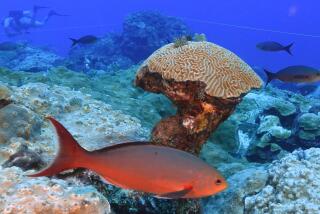Off Florida, a cemetery under the sea
- Share via
REPORTING OFF KEY BISCAYNE, FLA. — With a spray of water, Guy Gleichmann surfaces from a 40-foot dive during which he helped set his mother’s remains in their final resting place: a sunken city where brightly hued fish shimmy among fantastical architecture.
“I didn’t want to leave,” Gleichmann says, doffing mask and mouthpiece. “It’s so beautiful down there. It’s so serene.” The 48-year-old investment manager and diver from Pompano Beach, Fla., wanted a unique and accessible spot for his mother, Emma, who died in December at age 75. So he had her cremated remains mixed into concrete in the shape of a seashell, which was placed near the statue of a lion.
Ashes to ashes, dust to deep.
Emma Gleichmann was one of nearly 60 souls whose cremated remains rest in nautical sculptures on the sea floor about three miles off Key Biscayne at the one-of-a-kind Neptune Memorial Reef. The alternative burial option creates an environment for reef creatures and a destination for divers.
“It will always be a special place when I go diving, to come out here and be where she’s at,” Gleichmann says. “It just gives you a feeling that they’re not totally gone.”
The reef, a subsidiary of the Neptune Society, the nation’s largest cremation company, opened in fall 2007 after four years of permitting hurdles. It encompasses 16 acres and features oversize sculptures: arches, columns, gates and benches, all designed by Key Largo artist Kim Brandell.
“I was trying to achieve some sort of sunken city, but not Atlantis,” Brandell says, calling his architectural style futuristic rather than classical.
The scale is appropriately gargantuan for an undersea necropolis: 5-ton columns on 50-ton bases, arches soaring 25 feet. About a tenth of the underwater sculpture garden has been developed, says project manager Jim Hutslar. When the entire reef is completed, perhaps in 10 years, its rings and spokes will resemble a massive mandala. Leaping dolphins, chariots and Neptune himself are planned as future monuments.
In the company’s Deerfield Beach plant, Hutslar mixes a client’s cremated remains into special underwater concrete in 10-pound sculptures of starfish, shells and coral. Family members can watch or participate. Some place small tokens from the deceased in the mix -- fishing lures, angels or rosaries.
“Sometimes I warn the family,” Hutslar says. “ ‘If you start crying, I may cry.’ ”
On the reef, the sculptures are affixed to pavers along paths or set into columns and statuary. They eventually will be covered with coral, but plaques reveal who resides there. The cost is $2,600 for a standard placement of cremated remains. A cremation and placement package runs about $4,000.
Appealing to sea lovers, the reef is home to the remains of boat captains and divers. Others desire a unique alternative to the graveyard. “We’re seeing a lot of baby boomers because it’s different,” says Stephen Ziadie, Neptune Memorial Reef’s chief operating officer.
Fish swarm there by the hundreds; an eel and two stingrays have taken up residence. “As I’m working, they’re around my hands, trying to see what I’m doing,” Hutslar says.
Of the 1,200 spots in the reef’s initial development, more than half have been sold, he said. The company doesn’t own the site -- it’s in international waters -- but has federal and state permission to build on it.
Hutslar makes several maintenance dives to the reef each week, and places the remains of five to six people there a month. Nine family members of one woman learned to dive so they could watch him set her sculpture. “They all got certified for that one event,” he says.
Ron Hink, 54, of Fort Lauderdale, suggested the reef for his mother, Edith, when she was in a hospice. “She just lit up and said, ‘Gosh, I love the idea. I’ve always lived on the water, and I’ll have waterfront property,’ ” he recalls.
Hink bought space in a column for himself, his wife and two kids. “One by one we’ll all go there,” he says.
--
More to Read
Sign up for The Wild
We’ll help you find the best places to hike, bike and run, as well as the perfect silent spots for meditation and yoga.
You may occasionally receive promotional content from the Los Angeles Times.






